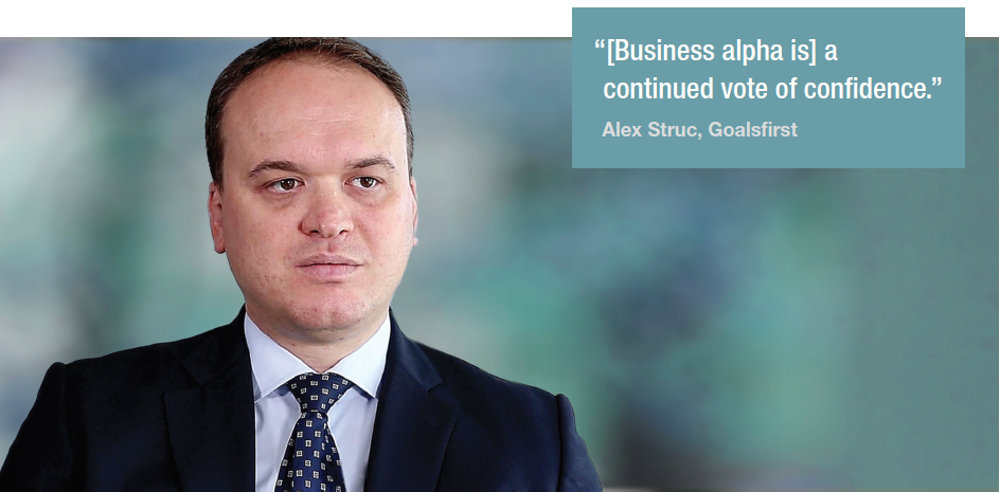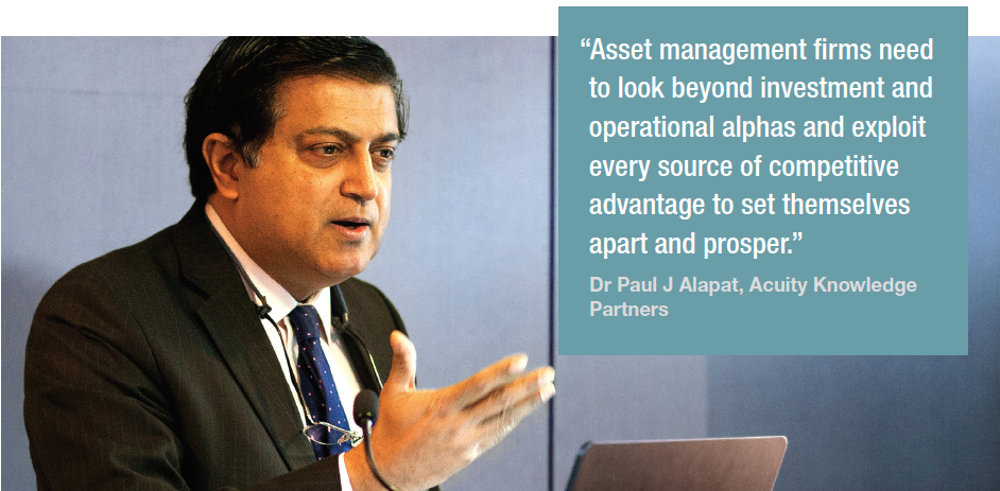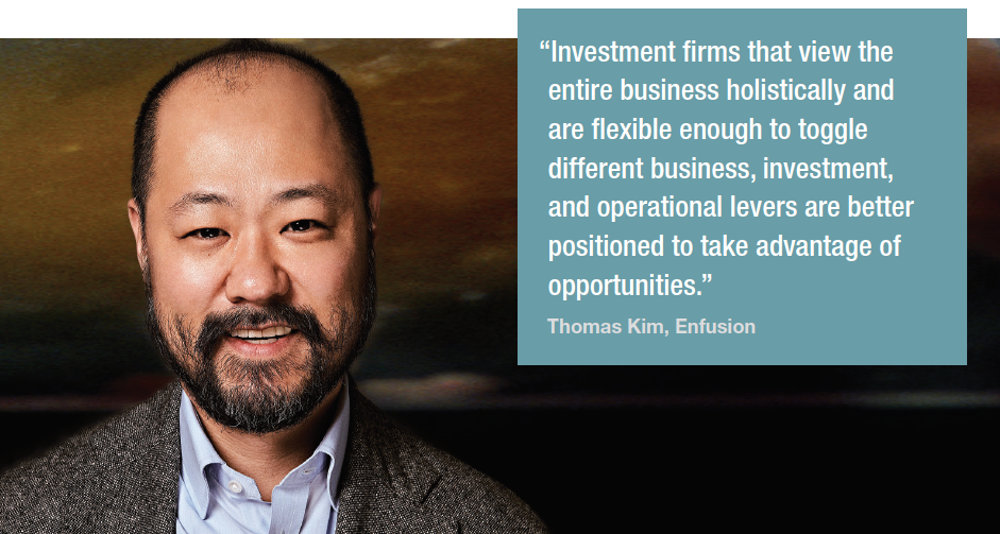 Getting the confidence of investors supports access to liquidity during choppy markets. By Ruth Emery
Getting the confidence of investors supports access to liquidity during choppy markets. By Ruth Emery
If your clients are sucking their cash out of a portfolio faster than a crypto investment, then liquidity flows in one direction. At that point taking advantage of falling prices is very difficult. However, if a fund manager can persuade clients to hold, or even add cash during a market sell-off, its trading desk and investment team can work long and short positions to generate alpha.
Business alpha refers to the way a business model can potentially create value for an investment firm. It is different to investment alpha, which is based on portfolio management decisions, and operational alpha, which is all about utilising better data and technology.
Business alpha, by contrast, revolves around attracting and retaining clients. Winning client loyalty can boost business profits but also generate investment returns. For example, retaining client confidence in a sell-off, as seen in March 2020, will minimise outflows and may allow its traders and portfolio managers (PMs) to employ dry powder to seize opportunities just as other firms are forced to ditch assets at a discount.

Alex Struc, CEO of fixed income boutique Goalsfirst, says, “It is relevant to all asset classes, not just bonds, and is as essential to performance as breathing is to sustaining human life. Business alpha is a licence to operate given to a manager by a client – investment outcomes will reflect if business alpha is being cultivated or depleted.”
In a nutshell, Struc describes business alpha as a “continued vote of confidence”.
If business alpha is all about the business model, it seems like something chief executives should pay attention to, rather than traders and portfolio managers. However, Struc insists that business alpha should trickle down to everyone, and not just be kept at the top of an organisation.
“For the CEOs, business alpha is very real,” he says. “Traders and portfolio managers often don’t understand it because the further down the chain you are from the chief executive, the more fragmented the decisions and understanding of the whole picture become. Start-ups may be in the best position to cultivate business alpha across ranks. But as they get bigger, it can also get lost.”
“The portfolio managers often think the returns are all down to skill [investment alpha]. They fail to realise it’s also due to the inflows – if the client money is coming in, they can buy equities and bonds at market lows, and that will boost returns. Focusing on business alpha is one of our USPs.”

Alexander Millar, head of UK distribution at Invesco, is another business alpha believer. He notes, “Increasingly generating outperformance is table stakes. In order to really work with clients, firms need to deliver the appropriate performance to the clients’ needs in the right way to meet their goals. Very often that means combining capabilities. This is why you are seeing the rise of solutions capabilities and a shift from active versus passive to active and passive.”

The focus on business alpha is a relatively new phenomenon, according to Dr Paul J Alapat, chief product officer at research firm Acuity Knowledge Partners. “Ten to fifteen years ago, asset managers were happy with the returns generated over benchmarks and the limited efficiencies achieved in technology and processes. However, the environment has become challenging with greater regulatory pressures, evolving investor demands, and competition from private equity and passive management,” he comments.
“Asset management firms need to look beyond investment and operational alphas and exploit every source of competitive advantage to set themselves apart and prosper. In many ways, business alpha offers the most comprehensive set of options to sustainably generate this surplus and deepen an asset manager’s differentiation.”

Prioritising resources tends to lead to focus on operational issues, and the returns these can generate, yet Thomas Kim, CEO of investment technology firm Enfusion, an expert when it comes to operational alpha, say that both need to be balanced.
“Business alpha is equally as important as operational alpha,” he notes. “Investment firms that view the entire business holistically and are flexible enough to toggle different business, investment, and operational levers are better positioned to take advantage of opportunities.”
Built-in alpha generation
The million-dollar question is how do you generate business alpha? Investment alpha and business alpha are naturally interconnected. If a firm has a robust investment process and generates outperformance, that can be a way to create trust and win client loyalty, which in turn creates business alpha. However, looking at business alpha purely through this lens has its limitations, cautions Struc, especially when managers fail to acknowledge emerging risks like megatrends or are slow to anticipate evolving client needs.
There are myriad ways to cultivate business alpha. It can be about scale or providing niche expertise. It can stem from offering a range of asset classes, investment styles and products, or a holistic service, such as working with wealth managers and providing thought leadership.
“Having a scale and diversity to your business is helpful for several reasons,” says Millar. “One is the ability to partner and bring a broad range of resources and solutions to bear, the other is to provide stability as a counterparty. A broad and balanced business that can weather market cycles is important to long-term clients, particularly those that value long-term relationships and like reassurance that the business will continue to be there to work with them.”
According to Millar, clients are increasingly choosing a smaller number of firms to have deeper partnerships with. “This is partly because of the complexity of managing multiple manager relationships and partly because client needs have become more complex through regulation and the desire to provide strong outcomes for the end client rather than simply performance above a standard market benchmark.
“This could be about working with a client to determine their ESG [environmental, social and governance] policies and then investment strategies to implement them, or understanding the regulatory environment the client is operating under (Solvency II, for example) and being able to provide appropriate investments packaged, delivered and reported on in the right way.”
The huge appetite for ethical investments means that including ESG criteria in a mandate is a no-brainer: firms increasingly need to do this to attract clients. However, taking ESG one step further can create business alpha. For example, those that prioritise the governance of environmental and social aspects of a portfolio can strengthen the link between investment process and client expectations, according to Struc, which in turns creates confidence and extends the performance cycle.
Designing innovative ESG products is another route, as Alapat explains: “Elevating the product manager’s role to pre-empt investor requirements and come up with innovative products and processes can generate business alpha – front-runners in ESG integration are reaping the benefits today.”
Getting innovative with your fee structure, such as introducing performance-based fees, and improving communication and reporting can also secure client loyalty.
Outsourcing is another approach. “Successful asset management firms may look to utilise offshored/outsourced support as a business model not just to cut costs and improve margins, but also to scale investment bandwidth and reduce time to market and ultimately improve investment alpha, which in turn feeds into stronger business alpha in a virtuous cycle,” says Alapat.
The two-million-dollar question is how to measure business alpha? Struc has a simple answer: “One could measure it by comparing the total returns of £50bn+ mega-funds in 2020. Those with a stable flow outperformed funds with more volatile profiles. For example, last March, where we saw abnormally big outflows across the market, those funds that managed to minimise this – and actually attracted new money – could pick up cheap assets.”
According to Struc, the outperformance across most assets in 2020 was predicated on how well investment managers could monetise the drawdown. He claims: “Skill seldomly had anything to do with it – business alpha drove outperformance, i.e. clients sticking with and allocating more to a strategy.”
Business alpha can also be the secret weapon for active managers against the growth of passive investments. Exchange traded funds are more easily sold off by investors, as Struc comments: “Active funds can achieve better Sharpe ratios than ETFs, or put simply, they reduce stress-induced temptation to reallocate risk during the bouts of volatility.”
Active managers arguably have more avenues than ETF providers to generate business alpha. According to Alapat, active managers can build bigger barriers to entry and defend greater pricing premia and client loyalty. “That said, exploiting this edge also requires well-informed judgment and timely decision making, keeping future market trends and evolving investor tastes in mind – it is not a given.”
As a final note, Struc reinforces that it is vital portfolio managers and traders understand this third alpha, and keep an eye on the trio at all times.
“Overall performance is a direct function of three alphas: investment, business, and operational,” he says. “As the commoditisation of financial technology reaches scale, one cannot compete without a good grasp of business alpha.”
©Markets Media Europe 2021
©Markets Media Europe 2025












